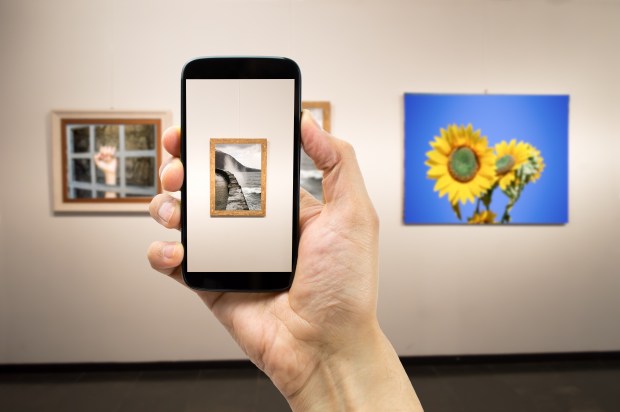The Art Of Business In The Online Art Marketplace

For many years, as communication, commerce and even crafting (see: Etsy, Pinterest) migrated to digital spaces, the art world stayed behind, lingering in brick-and-mortar museums, galleries and auction halls. People thought no one would ever buy art online, sight-unseen. They were wrong.
“The art world has been one of the industries most resistant to change and to moving online,” said Anna Carey, a spokeswoman for the online art marketplace Artsy, a global platform for discovering and collecting art.
In recent years, market reports have shown that art as a business has seen a lot of consolidation, shrinking the overall market size – but one avenue is expanding, and that’s online. People are getting used to the idea; they’re starting to see that discovering and collecting art digitally just makes sense.
“The market as a whole has gotten smaller, but the online market has grown,” Carey said. “Where there might be some uneasiness in the market at large, there’s a lot of optimism and positivity in the online market and a lot of opportunity for growth. The market is headed in that online direction.”
Exhibit A? Since its founding in 2009, Artsy has grown to encompass more than 800,000 pieces of art by 70,000 different artists. It partners with top-tier auction houses, art fairs and 1,800 of the world’s leading galleries. It facilitates over $20 million in sales each month.
Artsy proved that the world was ready to do something the connoisseurs and purists never thought it would try. And it’s only continuing to drive the point home after its latest Series D funding round generated $50 million in new investments, catapulting it to a $275-million valuation.
The round was led by Avenir Growth Capital, with further investments by industry leaders in art, media and technology – some who have supported Artsy from the start and others who were just finding out about it. Some new board members were also part of the round.
There are plenty of art marketplace platforms out there. Why put their money on Artsy? According to Carey, it’s because the platform brings together so many different elements. While others may offer auctions or a gallery experience or an editorial publication, Artsy brings all of those things together.
Another differentiating factor is Artsy’s broad appeal. The marketplace hosts artwork by the Picasso and Andy Warhol, but also by that guy painting in a converted warehouse down the street. Works range in price from $100 to $500,000.
New collectors who don’t yet know what they’re looking for can get help from Artsy’s recommendation engine. The engine, powered by the Art Genome Project, categorizes art based on 1,000 different characteristics from subject matter to style and also pulls in a user’s past likes and favorites to provide a tailored recommendation.
Seasoned collectors, who often come to the platform with a very specific need in mind, can leverage the same algorithm to help them find it. They can scour works by a single artist from any and all galleries that partner with the site and compare prices by submitting inquiries on all of them. That capacity for research lends buyers confidence as they determine their next art acquisition.
But that’s just the gallery side of the Artsy business model. The other side, and the side that’s growing faster, is the online auction house. Carey said that’s where the company will be focusing the funds raised in the recent investment round.
After running several benefit auctions over the years, Artsy decided to try hosting commercial auctions in 2015. It held two week-long auctions that year, partnering with external auction houses to do so.
In 2016, the site launched live auction integration allowing users to bid in the auction rooms of top-tier auction houses like Christie’s, Sotheby’s, Phillips, and Heritage without being physically present. As bids roll in through the Artsy platform, a representative in the room participates on users’ behalf.
That year, Artsy hosted 41 commercial auctions, and this year, it’s on track to quadruple that number, Carey said.
Other investments came from L Catterton, Thrive Capital, Shumway Capital. Leaders in art, media, and technology also supported the round, including Larry Gagosian (founder of Gagosian Gallery), Joe Gebbia (Airbnb co-founder), members of the Rockefeller and Acquavella families, Greg Maffei (Liberty Media) and Dasha Zhukova (Artsy co-founder, founder of Garage Museum of Contemporary Art).
Finally, a good chunk of support came from current board members Wendi Murdoch (Artsy co-founder and film producer) and Sky Dayton (Earthlink, Boingo), plus new board members Rich Barton (Expedia, Glassdoor, Zillow) and Bob Pittman (MTV co-founder, iHeartMedia CEO). Andrew Sugrue (co-founder of Avenir Growth Capital) joined the board as part of the round.
“Despite an estimated $3 trillion of art assets in the world, only $44 billion trades in a given year – and less than 2 percent of qualified buyers participate in this market due to high transaction costs, long lead times and limited transparency on pricing and value,” said Sugrue. “We believe Artsy will bring this last major consumer category online and thereby substantially expand the size of the global art market.”
